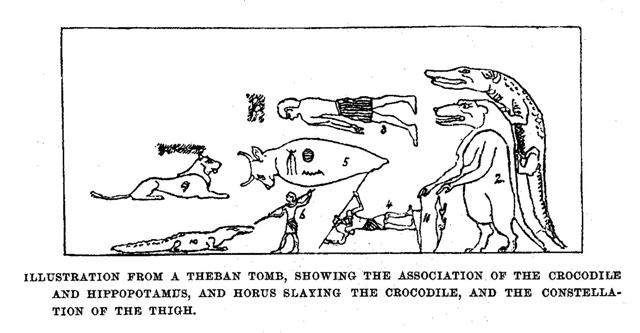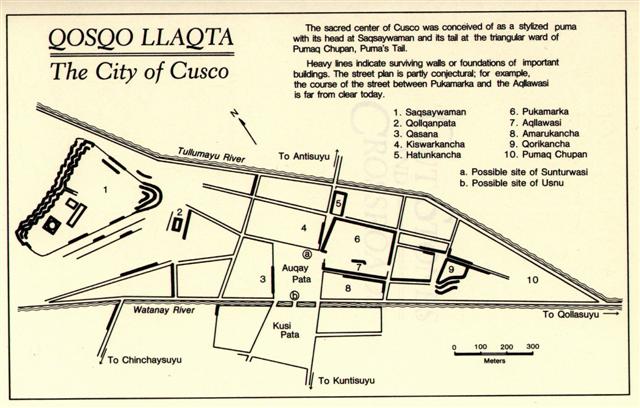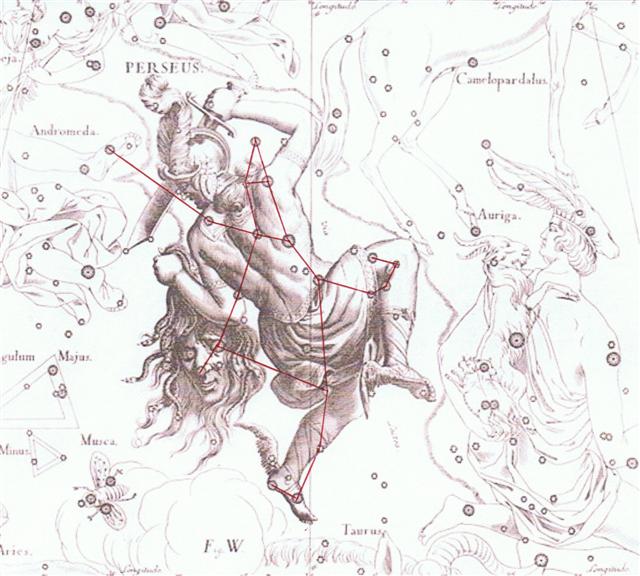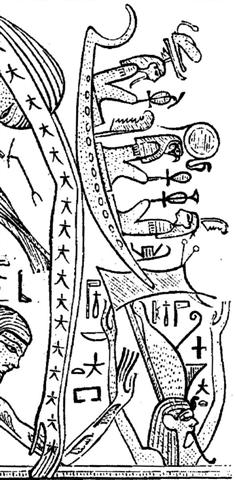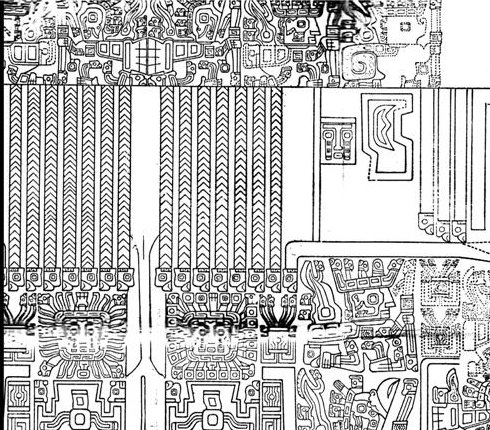Precession had pushed the conjunction between Leo and Virgo ahead in the year from where once upon a time the Fire in the sky and Mother Earth had been joined at midsummer.  ... The Mnajdra Temple is located on Malta and very ancient, dating to the time before the pyramids. Marija Gimbutas: 'To sleep within the Goddess's womb was to die and to come to life anew' ... ... Then I become aware of ... a presence - a faint, ghostly glimmering, like moonglow, that has appeared on the solstice stone. I don't know how long it lasts, a second or two only I would guess, but while it is there it seems less like a projection - which I know it to be - than something immanent within the stone itself. And it seems to function as a herald for it fades almost as soon as it has appeared and in its place the full effect snaps on - instantaneously. It wasn't there, and then it's there. As Chris had described, the effect does curiously resemble a poleaxe, or a flag on a pole, and consists of a 'shaft', narrow at the base but widening a little towards the top, running up the left hand side of the solstice stone, surmounted by a right-facing 'head' or 'flag'. An instant later an almond-shaped spot of light, like an eye, appears a few centimeters to the right of the 'flag' and the effect is complete. Weirdly - I do not claim it has any significance - this flag-on-a-pole symbol is the ancient Egyptian hieroglyph neter, meaning 'god', or 'a god' - and not to be understood at all in the Judaeo-Christian usage of that word but rather as a reference to one of the supernatural powers or principles that guide and balance the universe. Manifested here, in this strange Stone Age temple, it glows, as though lit by inner fire ... The measure from the northern midsummer to Alaraph (the Hind Leg of the Lion) indicated a precessional depth down to around (*178 - *92) * 71 = ca 61 * 10▓ years before the time of rongorongo (assumed by me to be 1842 BC):
At the time of Bharani this position in the year would have been in "August 5 (217) = 172 ("June 21) + 45. What were the Explorers doing at this time of the year? They were staying outside the cave into which they had carried the injured Kuukuu. There they formed 6 heaps of stones outside and probably it meant the rest of them would stay there in place until Tau-ono (6 stones, the Pleiades) arrived, i.e. for 136 ("May 16) + 365 - 217 ("August 5) = 284 days (= 7 * 60 - 136 = 364 - 80). ... The turtle got up, went back into the (sea) water, and swam away.
All the kinsmen spoke to you (i.e. Kuukuu): 'Even you did not prevail against the turtle!' They put the injured Kuukuu on a stretcher and carried him inland. They prepared a soft bed for him in the cave and let him rest there. They stayed there, rested, and lamented the severely injured Kuukuu. Kuukuu said, 'Promise me, my friends, that you will not abandon me!' They all replied, 'We could never abandon you!' They stayed there twenty-seven days in Oromanga. Everytime Kuukuu asked, 'Where are you, friends?' they immediately replied in one voice, 'Here we are!' They all sat down and thought. They had an idea and Ira spoke, 'Hey, you! Bring the round stones (from the shore) and pile them into six heaps of stones!' One of the youths said to Ira, 'Why do we want heaps of stone?' Ira replied, 'So that we can all ask the stones to do something.' They took (the material) for the stone heaps (pipi horeko) and piled up six heaps of stone at the outer edge of the cave. Then they all said to the stone heaps, 'Whenever he calls, whenever he calls for us, let your voices rush (to him) instead of the six (of us) (i.e., the six stone heaps are supposed to be substitutes for the youths). They all drew back to profit (from the deception) (? ki honui) and listened. A short while later, Kuukuu called. As soon as he had asked, 'Where are you?' the voices of the stone heaps replied, 'Here we are!' All (the youths) said, 'Hey, you! That was well done!' ... Once again. The Explorers arrived to the island in Maro 1, which was 64 (Bull) - 41 (Bharani) = 23 days before JUNE 1 (*72): ... The Explorers left Hiva in the 25th day of the first month (Vaitu Nui) and arrived in Maro 1. Probably these dates referred to the time when Bharani was at 0h, and then "April 25 would have been when the Sun reached Cursa (β Eridani) and "June 1 where Castor rose with the Sun ...
... Later on in this series of rituals, the Chorti go through a ceremony they call raising the sky. This ritual takes place at midnight on the twenty-fifth of April and continues each night until the rains arrive. In this ceremony two diviners and their wives sit on benches so that they occupy the corner positions of the cosmic square. They take their seats in the same order as the stones were placed, with the men on the eastern side and the women on the west. The ritual actions of sitting down and lifting upward are done with great precision and care, because they are directly related to the actions done by the gods at Creation. The people represent the gods of the four corners and the clouds that cover the earth. As they rise from their seats, they metaphorically lift the sky. If their lifting motion is uneven, the rains will be irregular and harmful ...
... They all climbed to the top of the hill. They climbed up on the tenth day of the month of June ('Maro') ... They made camp and constructed a house. Kuukuu got up, worked the ground, and heaped up the earth for the yam roots. Makoi got up and began to familiarize himself with the (new) land. (This took place) on the fifteenth day of the month of June ('Maro') ...
... Rangitokona, prop up the heaven! // Rangitokona, prop up the morning! // The pillar stands in the empty space. The thought [memea] stands in the earth-world - // Thought stands also in the sky. The kahi stands in the earth-world - // Kahi stands also in the sky. The pillar stands, the pillar - // It ever stands, the pillar of the sky ... ... The Explorers arrived at Rangi Meamea in "July 23 (Anakena 23) and there they stayed on the beautiful beach of Oromanga for 27 days ...
... There was no water in the village. The lakes and rivers were dry. Raven and Crow, two young girls who were having their first menstrual courses, were told to go and draw water from the ocean. Finding the journey too long, Raven decided just to urinate into her basket-bucket. She decieved no one and was severly scolded. Crow returned much later but with drinking water. As a punishment, Raven was condemned never to find water in the summer; only in winter would she find something to drink. For that reason the Raven never drinks during the hot months; she speaks with a raucous voice because of her dry throat ...
When at Ga5-1 the Sun (Kuukuu) had reached Hora Iti 2 then the Chained Hand of Andromeda (Manus Catenata, ι) would have been at the Full Moon.
We do no know with absolute certainty in what day the Turtle struck down Kuukuu, but probably it was in the same day as the Explorers had reached Rangi Meamea, viz. at heliacal Alkes. This had been the position of Sirius at the time of the Bull and JUNE 30 (*101) + 27 = *128 (JULY 27) at Mimosa (β Crucis). ... The Sensitive plant (Mimosa pudica L.) is a creeping annual or perennial herb often grown for its curiosity value: the compound leaves fold inward and droop when touched, re-opening within minutes. Mimosa pudica is native to Brazil, but is now a pantropical weed. Other names given to this curious plant are Humble plant, TickleMe plant, Shame plant, Sleeping Grass, Prayer plant, Touch-me-not, Makahiya (Philippines, meaning 'shy'), Mori Vivi (West Indies), mate-loi (false death) (Tonga) ... In the evening the leaflets will fold together and the whole leaf droops downward. It then re-opens at sunrise ... The suggestion is that Kuukuu would return later as fresh as new. It is therefore not necessary to interpret the arm at left in Ga5-1 as referring to Manus Catenata. Instead it is more likely to refer to the heliacal position, where Kuukuu (the Sun) reached day 214 at the time of Bharani. This was where the first star of Virgo was located (ω):
We should remember that the Proto-Sinaitic glyph corresponding to Greek zeta ... may have been called ziqq, based on a hieroglyph depicting a manacle ... Which means the powerless arm at left could be the result of the Lion King's contact with Virgo (Mother Earth): ... from the beginning of mankind sex has been a battle which women win, turning the death of the man (detumescence) into the life of the people (the child). Maori say, 'the genitals of women are killers of men' ...
Something similar could have been visualized in Ga6-2, at Hora Nui 2 where Hotu A Matua had left his old homeland:
... On February 9 the Chorti Ah K'in, 'diviners', begin the agricultural year. Both the 260-day cycle and the solar year are used in setting dates for religious and agricultural ceremonies, especially when those rituals fall at the same time in both calendars. The ceremony begins when the diviners go to a sacred spring where they choose five stones with the proper shape and color. These stones will mark the five positions of the sacred cosmogram created by the ritual. When the stones are brought back to the ceremonial house, two diviners start the ritual by placing the stones on a table in a careful pattern that reproduces the schematic of the universe. At the same time, helpers under the table replace last year's diagram with the new one. They believe that by placing the cosmic diagram under the base of God at the center of the world they demonstrate that God dominates the universe. The priests place the stones in a very particular order. First the stone that corresponds to the sun in the eastern, sunrise position of summer solstice is set down; then the stone corresponding to the western, sunset position of the same solstice. This is followed by stones representing the western, sunset position of the winter solstice, then its eastern, sunrise position. Together these four stones form a square. They sit at the four corners of the square just as we saw in the Creation story from the Classic period and in the Popol Vuh. Finally, the center stone is placed to form the ancient five-point sign modern researchers called the quincunx ...
In order to have the later Chorti ceremony of raising the sky arriving 115 days after MARCH 21 (at the heliacal Thigh and the midnight culmination of the Tail of the Swan) it would have been necessary to first reverse the 'change of sex' (from Bull to Ox) in the 27 days of the Extended Net (from ε up to and including μ Hydrae). I.e., to reverse the change from heliacal to nakshatra reading beyond Heze. To the 4 directions of the flat earth the zenith direction had to be added, and this was accomplished by the ceremonies beginning in February 9 (40). ... By Papa-tuoi, Thin Earth, Atea was the mother of children who became artisans for Rai-tupua-nui, Great-Sky-builder. They assisted him in erecting the ten heavens above the earth. In the highest of these dwelt the god Tane, so it was called the Sky-of-the-sacred-omens of Tane and Sky-of-the-water-of-life of Tane. The next highest heaven was called Hiro's Sky-of-prophets. Atea then became the wife of Rua-tupua-nui, Source of Great Growth, and they became the parents of all the celestial beings, first the shooting stars, then the Moon and the Sun, next the comets, then the multitude of stars and constellations, and finally the bright and dark nebulae. When this tremendous task had been accomplished Atea took a third husband, Fa'a-hotu, Make Fruitful. Then occurred a curious event. Whether Atea had wearied of bringing forth offspring we are not told, but certain it is that Atea and her husband Fa'a-hotu exchanged sexes. Then the [male] eyes of Atea glanced down at those of his wife Hotu and they begat Ru. It was this Ru who explored the whole earth and divided it into north, south, east, and west ...
214 ("August 2) was a number which could be interpreted as 400 - 4 - 182 (= 314 - 100):
... The Sacred Book of the ancient Maya Quiche, the famous Popol Vuh (the Book of Counsel) tells of Zipacna, son of Vucub-Caquix (= Seven Arata). He sees 400 youths dragging a huge log that they want as a ridgepole for their house. Zipacna alone carries the tree without effort to the spot where a hole has been dug for the post to support the ridgepole. The youths, jealous and afraid, try to kill Zipacna by crushing him in the hole, but he escapes and brings down the house on their heads. They are removed to the sky, in a 'group', and the Pleiades are called after them ... ... Then there is a true avanger-of-his-father, the Tuamotuan Tahaki, who, after long travels, arrive in the dark at the house of the goblin band who tortured his father. He conjures upon them 'the immense cold of Havaiki' (the other world) which puts them to sleep. Then Tahaki gathered up the net given to him by Kuhi, and carried it to the door of the long house. He set fire to the house. When the goblin myriads shouted out together 'Where is the door?' Tahaki called out: 'Here is it.' They thought it was one of their own band who had called out, and so they rushed headlong into the net, and Tahaki burned them up in the fire. What the net could be is known from the story of Kaulu. This adventurous hero, wanting to destroy a she-cannibal, first flew up to Makalii the great god, and asked for his nets, the Pleiades and the Hyades, into which he entangled the evil one before he burned down her house. It is clear who was the owner of the nets up there. The Pleiades are in the right hand of Orion on the Farnese Globe, and they used to be called the 'lagobolion' (hare net). The Hyades were for big game ... |
||||||||||||||||||||||||||||||||||||||||||||||||||||||||||||||||||||||||||||||||||||||||||||||||||||||||||||||||||||||||||||||||||||||||||||||||||||||||||||||||||||||||||||||||||||||||||||||||||||||||||||||||||||||||||||||||||||||||||||||||||||||||||||||||||||||||||||||||||||||||||||||||||||||||||||||||||||||||||||||||||||||||||||||||||||||||||||||||||||||||||||||||||||||||||||||||||||||||||||||||||||||||||||||||||||||||||||||||||||||||||||||||||||||||||||||||||||||||||||||||||||||||||||||||||||||||||||||||||||||||||||||||||||||||||||||||||||||||||||||||||||||||||||||||||||||||||||||||||||||||||||||||||||||||||||||||||||||||||||||||||||||||||||||||||||||||||||||||||||||||||||||||||||||||||||||||||||||||||||||||||||||||||||||||||||||||||||||||||||||||||||||||||||||



